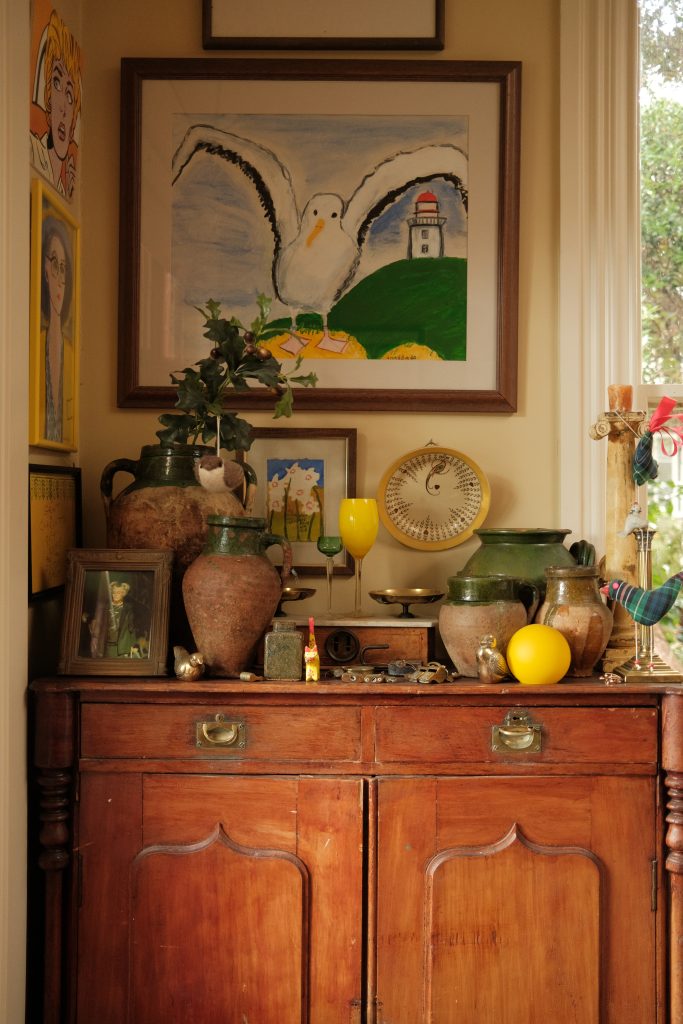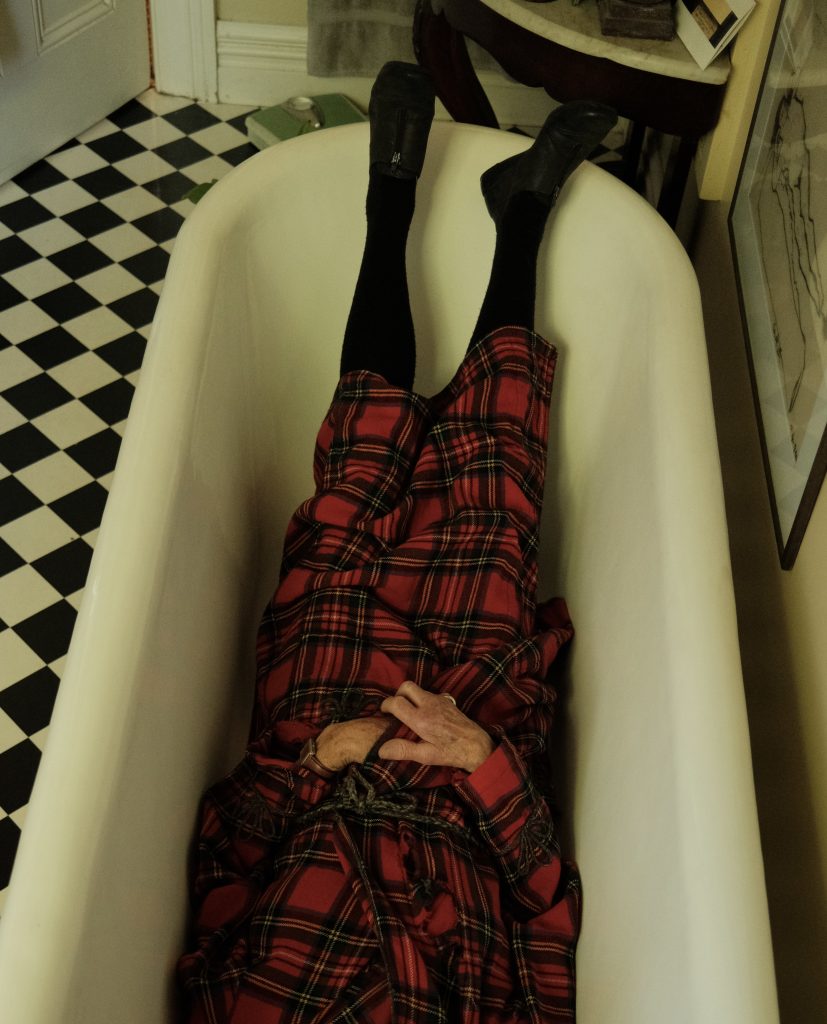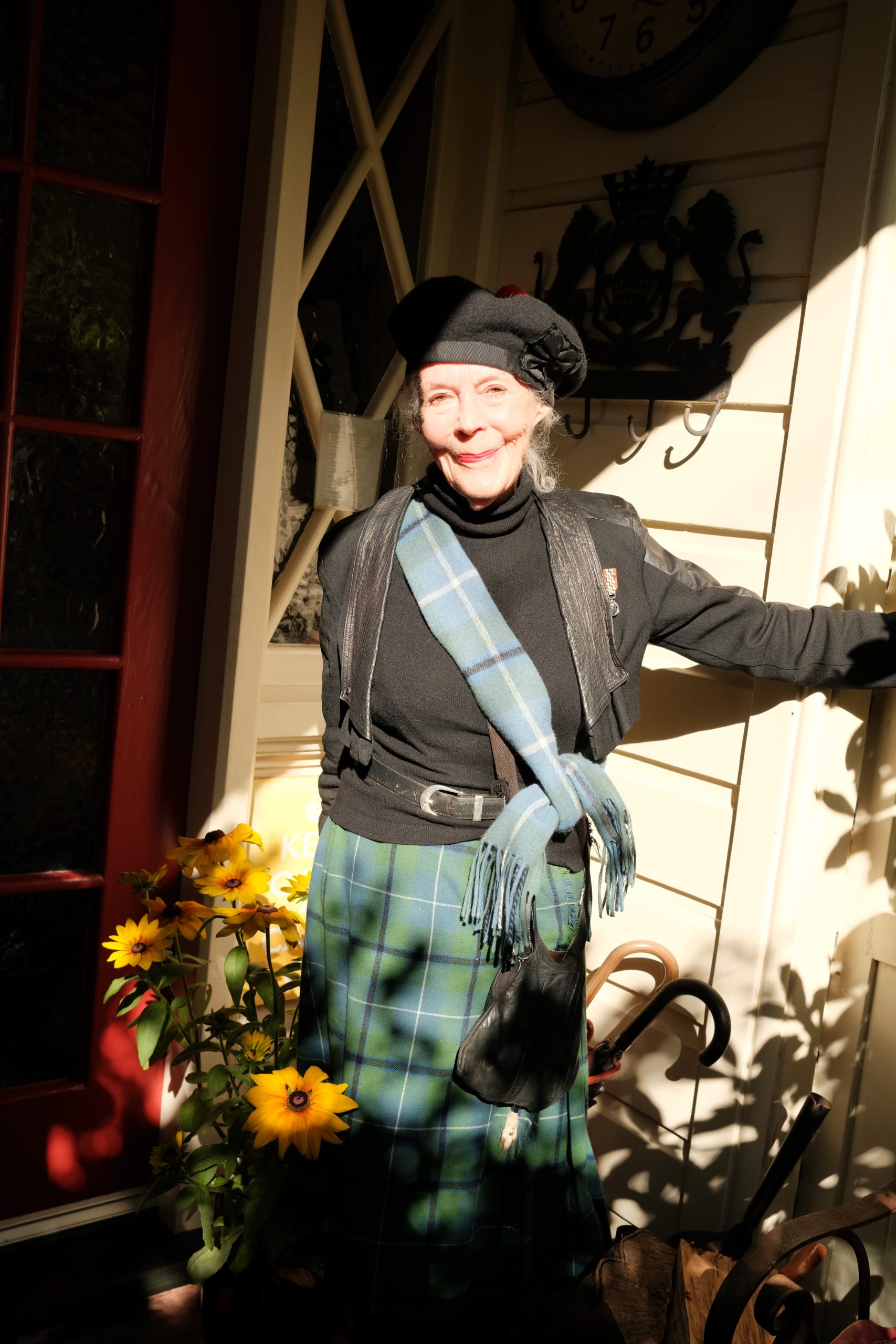Barbara Brinsley’s fashion sense was forged in the far south.

Dunedin is a city of grey stone and wind. Within it, Barbara Brinsley is a flicker of colourful defiance clad in, most days, head-to-toe tartan. She is a style icon in the small city, one who has been featured in Woman’s Weekly, NZ Life & Leisure and on Radio New Zealand, not to mention in an Instagram photo posted by the pop star Pink, who was in town to play Forsyth Barr Stadium: “ran into some serious style out there on the Dunedin streets today.” In 2003, at the age of 65, she was scouted while out walking by the harbour and invited to model at iD Fashion Week. Francis Hooper, the co-owner of the WORLD label, saw her there and asked her to walk for WORLD at New Zealand Fashion Week. He later referred to her as a “muse” for the brand.
Barbara Brinsley. The name has a sturdy, sculpted feel to it. She began her life as Barbara Blue, B. B. from the outset. Blue, the colour of the vast Waianiwa sky, a place characterised by its special soil. Nestled deep in Southland’s bosom, Waianiwa is where Barbara grew up, on a sheep farm. She lived in a house built by her grandfather. The windows framed the Takitimu Mountains. The low trees of her youth, she says, are now so tall they have swallowed the horizon.
Barbara’s long-standing love affair with fashion began to take flight when she lived in England in the early, swinging, 1960s. Barbara’s extensive collection includes labels such as Dior, Valentino, Jean Paul Gaultier, Alexander McQueen and Maison Margiela, plus a range of her favourite New Zealand brands. She has a preference for the pre-loved, and she is a familiar face in local op shops; they’ll set aside treasures for her, like a $15 Vivienne Westwood shirt. (She has a particular affinity for Westwood, a kindred spirit who also held a deep appreciation for tartan.)
One piece, a black Zambesi jacket the colour of a long, slow night that hangs on her bedroom door, hints at the other reason people know her name. It bears a Queen’s Service Medal, awarded in 2019 for “services to art curation”. This is a nod to her impact as Dunedin Hospital’s Aesthetic Coordinator. The voluntary role has involved restoring and expanding the hospital’s art collection, transforming sterile corridors into vibrant and important gallery spaces. She believes, as expressed in the Latin phrase she often cites, that ars longa, vita brevis (“art is long, but life is short”).
My knock on her front door is greeted by a “come straight through, dear”. She requests I open the sparkling Perrier water and conjures two Perrier branded glasses for us out of thin air. Brick-red walls frame the living room where knee-high stacks of books form winding pathways around the furniture. I take care not to step on Marti Friedlander’s weighty tome of self-portraits. The couch is wrapped in Liberty fabric from London. It is unmistakable: the Zebak pattern, a Collier and Campbell design from 1984 that echoes the earthy browns of the Waianiwa soils that nurtured Barbara’s childhood. I recognise it immediately. It is the very same fabric that adorned our family sofa. My gaze falls upon her hands. They rest near a grouse foot, its fur and claws intact, pinned to her tartan kilt. A glob of silver wraps her finger.
“Do you know what a needle and thread is?” she asks me, in a playful accusation. “I can sew on a button,” I reply. Barbara learned the quiet craft of sewing from her mother. Then, at 17, in a more formal immersion in the dressmaking arts in Invercargill on a five-week intensive, she mastered the intricacies of tailoring: the precise cut of a lapel, the smooth set of a sleeve. This wasn’t entirely her own initiative, she explains. “My mother was taught to sew. She sewed for us and felt it would be a good thing. It was my mother’s direction, really.” Following the dressmaking course, Barbara transitioned into nursing. Her decision to pursue this path was influenced by common sense and family precedent. As she puts it, “My cousin did nursing, it was a practical thing to do.”
Nevertheless, she continued to stitch and baste. Before the abundance of ready-to-wear clothing, sewing skills were anyway somewhat of a necessity, especially for someone living in the country. “There wasn’t the availability of clothes, the racks of clothes that there are today,” she recalls, explaining “you weren’t going into town, you weren’t shopping every day. You were minding the lambs.” This environment fostered a practical approach to fashion; if she wanted something to wear, she made it herself.

Barbara sourced her fabrics, including tartan and tweed, from department stores like Invercargill’s H&J Smith. She later created a wide range of garments for her family: herself, her husband, and their children, Harriet and Andrew. She remembers making “skirts, blouses, and jackets because I was taught how to make a suit and do lapels and collars.” With “lots of patterns available in those days,” such as the popular Butterick patterns, she would lay out the tissue paper and cut the fabric. She made suits for her husband, Michael, from robust, woven Harris tweed. She shows me a black and white photograph from their wedding day. He passed away eighteen days before her fiftieth birthday.
Though Barbara does not own a sewing machine now, the instinct remains. She still mends. A button adrift, or a seam come undone can be fixed by her hand. Her skills have been passed down to her daughter, Harriet, who also sews. Barbara taught her.
A respect for the weather and a rural Southlander’s yearning for sturdy, functional clothing are two elements that continue to draw Barbara to tartan, especially the kilt. Her upbringing on a sheep farm instilled in her a dual appreciation for wool and refined presentation. Barbara cites the influence of her “well-dressed” parents. “It was the influence that I had being brought up in Southland … to dress yourself properly.” When going into town, Invercargill, one presented oneself correctly, nicely. The gumboots stayed at the farm. Early lessons from her parents are ingrained and unwavering. The checklist to leave the house has always been: hat, gloves, perfume (applied at least twice a day), and an essential ever-present smile.
Tartan, in this form, is also a physical embodiment of her Scottish heritage, a connection to her lineage through Clan Macpherson. Beyond its practicality, she admires the artistry of a kilt’s making. “It’s warm and colourful,” she explains, highlighting the kilt’s impressive “eight and a half yards of wool.” Its dense weave is essential armour against the southern cold. “It’s about protecting my body.” This is enhanced by the ever-present merino leggings she wears beneath it, an example of her masterful layering.
Barbara’s family owned the farm until her father, Duncan, sold it in 1963. Then 57, he decided to sell up and move, with Barbara’s mother, Athol Blue, to Invercargill. The property is now owned by someone Barbara went to school with in Waianiwa. Asked if she collected anything as a child on the farm, she swiftly retorts “pet lambs.” Her fondness for the intensity of their eyes has not waned. To illustrate, Barbara, who knows where everything is instantly in her own home, a 120-year-old villa overflowing with artworks, finds a book by Kathryn Dun, Beautiful Sheep.
Our conversation turns to art. Fishing line stretches from picture rails, supporting cascading frames. With the walls completely filled, she has begun positioning framed pieces in front of windows. When I ask for a pivotal piece of art that might have resonated deeply, she turns the question back on me, a playful challenge. Which one do I think it was? I offer the obvious, the Mona Lisa. “No.” Monet’s water lilies? “No.” Van Gogh’s sunflowers? “Yes.”
The memory is vivid and specific: the National Gallery in London, 1963. At the time, she was working in the A&E department of a hospital in Yorkshire. “Busier than any emergency clinic in New Zealand,” she remarks. She found immense satisfaction in the fast-paced environment, stating, “I find emergency work is very rewarding. It teaches you a great deal.” After the UK stint, Barbara and Michael moved back to New Zealand, and for four decades she dedicated herself to nursing at Dunedin Hospital. She specialised primarily in postoperative recovery, retiring in 2003 at the age of 65.
Nursing is a profession she would readily choose again. It taught her the fundamental importance of caring for oneself. After our meeting, she says, she will go to the gym for her daily 15-minute exercise. Her focus is on combating age-related muscle loss. She explains, “in 2020, I went to a lecture on sarcopenia, muscle loss, and I thought, God, that’s me, I’m losing a bit of muscle. So to tone myself up again, I go to the gym.” Rowing also became a key part of “gaining more muscle.” Barbara’s commitment manifested in a recent triumph at the Masters Games, a gold medal in rowing in the 85- to 90-year-old category. The caveat, that she was the sole competitor in the lightweight group, does not diminish the achievement.
During Barbara’s time as Aesthetic Coordinator at the hospital, one particularly successful fundraising initiative was the 2009 acquisition of Dame Robin White’s ‘Your Health Is Your Wealth’ (1972). It features green, fertile rolling hills, a light blue sky with a single cloud, and the sans-serif declaration ‘your HEALTH is your WEALTH’ in red. The budget would not cover the original artwork, so a novel approach was employed. The image was divided into 7,500 photocopied squares, each sold for $5. This method, which involved Barbara herself selling the squares, ultimately raised $37,500. The painting is currently displayed in the hospital’s main foyer.
Dunedin Hospital’s art collection, established in 1972 and now comprising more than 2200 individual works, holds a particular place in my tactile memory. My mother delivered numerous babies there, including my brother’s fiancée. I vividly recall tracing the patterns of Neil Grant’s ‘Otago Peninsula’ ceramic on my way in and out of the Great King Street entrance. That earthen map, set at the threshold, is more than just a depiction of land. It witnesses the rawest moments of human passage. Before it, you see the contrast. New babies in carriers, nervous parents waiting, people weighted with the heavy stillness of life-altering news. Families formed and fractured.
Barbara quotes Shakespeare to me, a piece she recited at her father’s funeral: “All the world’s a stage, / And all the men and women merely players; / They have their exits and their entrances, / And one man in his time plays many parts, / His acts being seven ages. At first, the infant, / Mewling and puking in the nurse’s arms.” She fetches a book of quotations to check if she said it accurately. Of course it was flawless.
Her platinum mink Tonkinese cat, Maisey, a sprightly eight-year-old, follows us into the bathroom. A lump of amber Pears soap glows on the edge of the white ceramic basin. Barbara steps into her water-less bath, lays down, and closes her eyes. She tells me it is her first time in there, ever. The taps are brass and bulbous. She is wearing her Royal Stewart dressing gown. It is second-hand, and the elbows are worn through. In its pocket a single white glove, tailored by her mother to ensure a perfect fit. The dressing gown is imbued with a future significance. She will be cremated in it. Leonard Cohen’s ‘Hallelujah’ and Edith Piaf’s ‘Non, je ne regrette rien’ will be the soundtrack.

We descend downstairs, a haven for her many guests. Her daughter and son have recently visited. She opens a drawer to reveal a loot of mesh pieces. “All the drawers in this dresser are full of Jean Paul Gaultier,” she declares. With Maisey threading between our legs, Barbara gives a quick tour of the downstairs rooms, flicking the lights on and off. Each space is defined in a perfect string of words. One room is “the washing machine and the champagne.” Veuve Clicquot, that distinctive orange, is a recurring motif throughout the house. Why Veuve? She tells me it is the one she has had the most fun with. Probing further she reveals a serendipitous discovery made in 2014 when she visited Épône and the Veuve Clicquot cellars. Barbe-Nicole Clicquot, who, like the name “Veuve” itself (“widow” in French), was also widowed young.
I ask her what she has for breakfast. “Toast and honey, Nescafé instant coffee.” For lunch, it is yogurt and a banana. Then, she suggests we have tea in her kitchen. I make it and, relieved I have done it correctly, I compliment the Annie Baird albatross painting above the round dining table. She’s a favourite artist of mine. Barbara then points out, in the hallway, opposite a hanging Burberry jacket, the portraits of herself by the same artist, recalling the hours spent sitting. I fight the urge to say “wow, that is SO cool!” Throughout our conversation, my occasional “cool” has been met with gentle reprimand. “Cool? You do not say ‘cool’ unless you have hypothermia, like I did when I was walking the Milford Track.” Tramping? Yes. Has she bungy jumped? Also, yes. “I do not mind standing at the edge.”
Barbara checks the behaviour of her silver hair. It is secured, with one pin, into its signature scroll. She trims it herself, a task handled with the same direct efficiency as pruning a tree. She does not, and has never, dyed her hair. She attributes its transition to silver to the stress of losing her beloved Michael. She is the epitome of self-sufficiency, and reminds me, with a wink, that she is the gardener, the caretaker, and the cleaner of her home, a hands-on resilience first forged during her Waianiwa upbringing.
Before my departure, she presents me with the guestbook to sign, a record of those who have crossed her threshold. My remark about it being a “great idea” is met with a swift correction: “Idea? It is just something that people do.” This last nugget dutifully recorded in my notebook, I hand her the Buckingham Palace shower cap she was drying in the sun on her porch. “Thank you, Constance. Come in the afternoon next time, so we can have champagne.”
Words and photos: Constance McDonald

